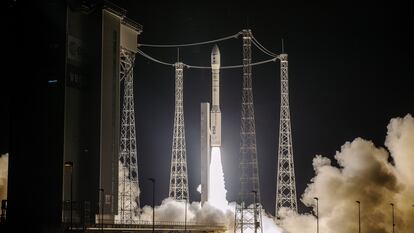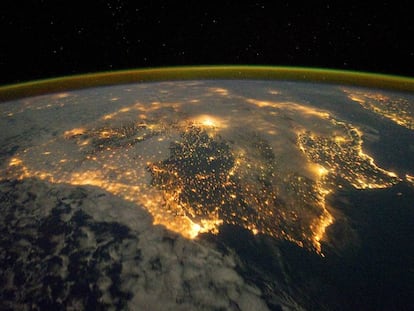Mission to launch Spain’s first Earth observation satellite fails after rocket veers off course
The European Space Agency reported a deviation of trajectory eight minutes after liftoff
The Vega mission VV17 to launch Spain’s first Earth observation satellite, SeoSat-Ingenio, failed on Tuesday after the rocket transporting it deviated off its trajectory. The rocket was launched from the Guiana Space Station in Kourou in French Guiana at 2.52am (Spanish mainland time), but malfunctioned eight minutes after liftoff, following the first ignition of the engine of the Avum upper stage, said experts at the space station in a transmission broadcast by the European Space Agency (ESA).
Before the transmission ended, the experts said that they were waiting to obtain more data to find out what went wrong. The rocket was also transporting the French satellite TARANIS. The Vega is a rocket developed by the Italian Space Agency and ESA to put satellites into orbit. Its first launch took place on February 13, 2012 from Kourou.
According to the plans of satellite launch company Arianespace, Vega was meant to separate Ingenio 54 minutes after liftoff and TARANIS 1.42 hours after liftoff. The plan was to release the Spanish satellite into a sun-synchronous orbit, at a height of approximately 670 kilometers.
Arianespace has begun to analyze the telemetry data to determine the cause of the malfunction and said it would hold a briefing on Tuesday afternoon to provide more information. Company officials have yet to respond to questions from EL PAÍS.
Spain’s first Earth observation satellite
The SeoSat-Ingenio satellite was the pride of Spanish aerospace engineering. It was set to orbit at a height of 670 kilometers, passing by the poles. The satellite would have been able to take photos of any point on Earth over three days and cover the entire territory of Spain eight times a year. These images would have been captured in the highest resolution ever achieved by a Spanish instrument thanks to the satellite’s dual camera. This camera has a mirror system that concentrates light, allowing an image 60 kilometers wide to be captured with each pixel representing 2.5 meters – a resolution that would enable an area approximately the size of a car to be seen in detail.
The photos taken by the satellite were going to be used for cartography, agriculture, management of natural resources (to check dam levels), emergencies and security. For example, the images could warn of fires, indicate nutrient levels of a crop to determine how much fertilizer to use and to detect illegal constructions.
More on the Vega flight #VV17 mission failure#SEOSATIngeniohttps://t.co/ibD24dTRc8 pic.twitter.com/Xfb3gEzhen
— ESA (@esa) November 17, 2020
The Spanish satellite’s dual camera would also have been able to look sideways as well as down, allowing it to observe any point on Earth over three days. According to a press release from the Spanish Science Ministry, this would have been especially useful in creating maps of unpredictable natural disasters such as floods, forest fires and earthquakes, as well as to strengthen understanding of one of the greatest challenges facing the world: climate change. Science Minister and former astronaut Pedro Duque presented a detailed report about the services the satellite could provide to public administrations at a Cabinet meeting last week. Ingenio could also have been used for military purposes, particularly as a complement to Paz, the radar satellite launched by the Defense Military in 2018.
The satellite project cost a total of €200 million and was led by the Science Ministry via the Center of Industrial Technological Development (CDTI). Some 75% of all the technology of Ingenio is made in Spain, making it the satellite with more national components that has ever been developed. Its creators had hoped that a successful orbit launch would have allowed Spain to compete to make more products of this kind, like those used in the Copernicus program run by the European Union and ESA.
English version by Melissa Kitson.
Tu suscripción se está usando en otro dispositivo
¿Quieres añadir otro usuario a tu suscripción?
Si continúas leyendo en este dispositivo, no se podrá leer en el otro.
FlechaTu suscripción se está usando en otro dispositivo y solo puedes acceder a EL PAÍS desde un dispositivo a la vez.
Si quieres compartir tu cuenta, cambia tu suscripción a la modalidad Premium, así podrás añadir otro usuario. Cada uno accederá con su propia cuenta de email, lo que os permitirá personalizar vuestra experiencia en EL PAÍS.
¿Tienes una suscripción de empresa? Accede aquí para contratar más cuentas.
En el caso de no saber quién está usando tu cuenta, te recomendamos cambiar tu contraseña aquí.
Si decides continuar compartiendo tu cuenta, este mensaje se mostrará en tu dispositivo y en el de la otra persona que está usando tu cuenta de forma indefinida, afectando a tu experiencia de lectura. Puedes consultar aquí los términos y condiciones de la suscripción digital.
More information
Últimas noticias
More than 40 Democratic lawmakers urge Trump in a letter to stop his ‘attempts to undermine democracy in Brazil’
The journal ‘Science’ criticizes Trump’s anti-renewable energy policy: ‘The US is failing to benefit from its own innovations’
Cubans hope for a miracle as dengue and chikungunya spread
The long shadow of the father figure in the films of Rob Reiner
Most viewed
- Christian Louboutin: ‘Young people don’t want to be like their parents. And if their parents wear sneakers, they’re going to look for something else’
- Cartels in Mexico take a leap forward with narco-drones: ‘It is criminal groups that are leading the innovation race’
- ‘El Limones’ and the growing union disguise of Mexican organized crime
- Liset Menéndez de la Prida, neuroscientist: ‘It’s not normal to constantly seek pleasure; it’s important to be bored, to be calm’
- The low-cost creative revolution: How technology is making art accessible to everyone












































